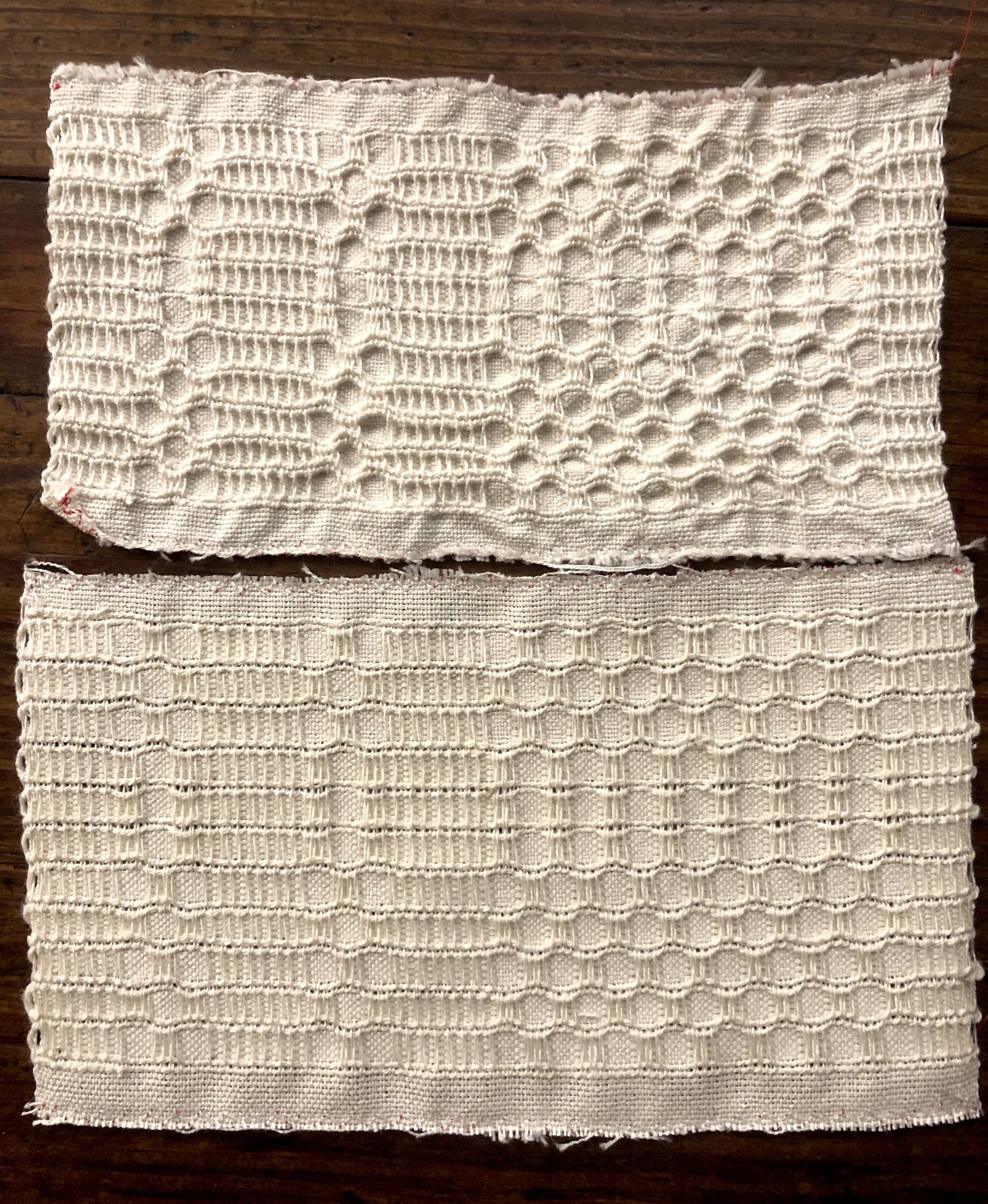I started out sampling Sarah’s drafts from Francis L. Goodrich’s Coverlets and Counterpanes (Miller & Schillo) with the first draft, titled “Dimity Stripe and Honeycomb.” I finally got my cone of 30/2 unmercerized cotton from Lunatic Fringe (truly the only place on the internet I managed to find unmercerized yarn in this size) and though it was too late to use it for class, I’ve been able to use it for the rest of my counterpane sampling.
I wound this warp to I think 6 yards to give myself enough room to sample all the drafts while cutting off and tying back on. I sett it at 40 to the inch which I think is the finest sett I’ve ever woven! I did the same as I mentioned in my previous blog post as far as sampling a bunch of different warps to find out which ones worked best. Although while using 20/2 thread I preferred using the same for weft, while using 30/2 I found that using that same thread doubled worked the best for weft in this case. In the picture below, my sample on the left uses 30/2 held double, and the right uses it held singly. Using doubled weft gives it a more full appearance which I liked a lot.
I also sampled a few options for honeycomb cord, and I liked an 8/2 unmercerized cotton best for that, although truth be told there wasn’t much difference between using that and using the 30/2 held double just as the cord in addition to the tabby thread. (You can see both on the left-hand sample above: the top section uses 30/2 doubled and the bottom section below the plain weave band uses 8/2.)
I wove this sample as I did the previous batch, working off of Sarah’s handwritten draft and her treadling patterns. To give you an idea of the treadling, here’s what she wrote for this draft:
“Tramp two on the right hand - throw in the cord as you see the dots,
Then two on the left hand and throw the cord again.
The two middle ones - one at a time till you get 8 threads, then put in the cord.
Then tramp the outside - one at a time till you get 8 threads.”
Luckily it seems that Sarah was working with a direct tie up so these directions were not nearly as inscrutable as I thought they would be at first glance. I did definitely forget to translate these to a jack loom treadling (which I’m working with) from what must have been a treadling written for counterbalance until I cut my first sample off the loom and flipped it over so it finally looked like the picture. :)
To finish up the sampling for this draft, I wove the same section of a pattern repeat twice, to have one sample for my book unwashed (below left) and one washed (above left). I’m planning to do this for each of Sarah’s drafts in this book. Not only does it show how the cloth changes during wet finishing, but it’s helpful to have a reference for how much shrinkage you get.
This first round of sampling helped me settle on which wefts I will use for the rest of the drafts and also helped me work through the more mysterious aspects of the way Sarah wrote out the patterns.
Project details:
draft: Sarah Nelson No. 1: Dimity Strip and Honeycomb
Warp: 30/2 unmercerized cotton from Lunatic Fringe
Weft: samples various wefts, settled on 30/2 unmercerized cotton held double for tabby, and 8/2 unmercerized cotton for honeycomb cord
40 ends per inch
7” wide (I used up every heddle on this tiny loom lol)
~6 yards warped

